What is dog reactivity? How do you handle a reactive dog? Well, simply put, reactivity is when your puppy reacts to things in the environment. Common reactions include barking, growling, and lunging. That doesn’t mean that you have a reactive dog. There is a difference between showing aggressive behavior and reacting. Today, I will talk about some dog reactive training and how it works.
It is common for dogs to react to things in their environment. We all do. Yes, having a dog showing reactive behavior can be a challenge and difficult to handle. But do not worry, there is a solution to every problem. A little bit of training and socialization goes a long way.
Why Should You Do Something
I know first-hand that a dog that reacts is a burden for any dog owner. You are not able to walk with your dog without fear and anxiety. But instead of trying to live with having a reactive dog, you can learn how to keep your puppy calm and focused on you. That will make things much better for you and your canine companion.
Most dogs show leash reactivity. Usually, when we talk about a reactive dog, we talk about a leash reactive dog.
Your dog might be calm and well-mannered when off-leash, but when they are on a leash, things get messy.
I can assure you, that there is nothing wrong with your beloved puppy. There is no such thing as aggression in him. He just reacts to triggers. The goal is to identify those triggers and manage them.
Understanding Your Reactive Dog
A lot of dog reactivity originates in discomfort. We, humans, are the same. Are you comfortable in every situation? How do you react when you are put in an uncomfortable situation? Some people react defensively and try to argue back. Well, dogs are the same.
Your canine friend is not an aggressive dog. He does not want to attack another dog, animal, or human per se. When put with his back to the wall, your dog sees its reaction as the only viable option.
Usually, this happens when you have a puppy on a leash. If your puppy was off-leash, he might have chosen to walk past that uncomfortable scenario and continue walking. Avoid the situation, right?
Well, when it is on a leash, he feels discomfort and that might originate from different sources. Some dogs are territorial and they consider you their territory. When they feel you are nervous and anxious, they react.
So, it is best that you maintain a calm and collected attitude and behavior when your dog is scared. Be the one to calm him down.
What You shouldn’t do?
A lot of dog owners make simple mistakes over and over again when they deal with a reactive dog. Today, a big part of the dog reactive training techniques we will talk about are to make sure you are calming your dog. Here are some things you should not do:
- Do not try to enforce dominance training with a reactive puppy, you might trigger even for reaction
- Do not get nervous with other people and dogs around your puppy, try to act calm and praise your dog with positive reinforcement
- Never go to the dog park to try and socialize a reactive dog. You will end up with an even more fearful dog and even more reacting puppy
- Do not punish your puppy for its reaction. Instead, try to find the root of the problem
- Avoid long dog training sessions. A quality training session is between 5 and 15 minutes
A simple trick for reactive dogs
I said today we will talk about reactive dog training methods and techniques. There are a couple of methods you can use to alter unwanted behavior from your dog. Dog bark, dog aggression, those are all things you do not want, right?
Well, here is a simple trick you can use. But you have to teach your dog first how to do it. What is the trick?
- When you notice your dog is on alert (pay attention to body language), simply redirect its attention
- Instruct your dog to look at its paws and shush
- These two commands will instantly calm your dog and distract him from the trigger. We can call this technique stimulus blocking
Now, before you try this in public, you have to teach your dog at home. Practice at home. The best way for behavior modification is with operant conditioning, which includes lots of positive reinforcement. Basically, give your dog treats for doing something positive.
Using Tug Toy to Solve Reactivity
Some dogs are food-driven, and others are toy-driven. If your reactive dog is driven by toys, then you have an easy path to reducing unwanted behavior.
I suggest using a tug toy for redirecting your dogs focus toward you. Food is not the best option here, because when other dogs are involved, they might all go for the food. And a ball will turn your dog into a moving target.
A tug toy, on the other hand, will make your dog focused on you, and only you. The dog comes to you. Tug is basically a free recall.
So, what do you do? Well, you always carry a tug toy with you on walks. And when you see a dog coming your way, and you know your dog will react, simply pull out the toy and play tug for a couple of seconds.
Your dog will ignore the reactivity trigger in its environment, and things will go smoothly. Sounds fun, right?
Helping Your Dog Be Calm
As I said before, there are a couple of ways to prevent your dog from reacting. One is with the trick we talked about, the other is playing tug, and then there are ways to keep your dog calm.
For this matter, you have to go deep into your canine’s psychology. If psychology has taught us anything, it is that we can alter feelings linked to a certain situation.
If you have reactive dogs, these feelings are emotions of profound stress and anxiety. Your dog shows aggressive behavior and reactivity because the other dog elicits these feelings in him.
But you can change those feelings to a calm, neutral, and with lots of dog training, even happy state of mind.
What is the trick? Well, you give your puppy something awesome every time he sees his trigger. And that will mean that the trigger predicts the appearance of awesome things. It is operant conditioning 101.
If you use food, you have to pick something that you do not use for any other context. This is the only time you use that valuable treat. Say, chicken pieces. You start working and find your dogs threshold.
Call a friend with another dog, and make him come to you. Sit with your puppy, and the minute your dog reacts to seeing the other puppy, you call him and start feeding him with a special treat.
Then, you have the triggering dog leave the situation and you stop feeding your puppy. The goal here is to give your dog an association that the scary dog means favorite food will come out, but he has to focus on you.
Repeat it as often as possible. In the beginning, start feeding from a larger distance. And then, work your way up to being close to the other dog. You will easily see your dogs threshold.
Dog Reactivity Chart
I talked several times about thresholds, paying attention to body language, and so on. But let’s break down the dog reactivity chart. That ensures you have success in your dog reactive training.
- Green zone: your dog can sniff, can take treats, keeps the leash loose, and can listen to and accept cues and commands
- Yellow zone: your dog shows alertness, stares at the trigger, doesn’t sniff anymore, and might need several cues, not one
- Orange zone: your dog has high body tension, might growl or give a single woof, doesn’t accept food anymore and is straining on the leash
- Red zone: your dog is clearly barking and lunging, doesn’t respond to treats or cues, and if he is close enough to the trigger, might go for a bite
The ideal zone, of course, is the green zone. Keep your puppy in it whenever possible. You can still do some dog training in the yellow zone. In the orange zone, things are seconds from blowing up.
So, what do you do? Well, with the tricks and methods we talked about before, you try to keep your dog’s threshold in the green zone.
Is there such a thing as an aggressive breed or a reactive breed?
This is a question many people ask. What are the most reactive dogs and most aggressive breeds? Well, there is no such thing. Even a Golden Retriever might react if not socialized and trained properly. I can vouch for that, we have had an incident with a Golden when Milo was young in the dog park.
Every breed can produce reactive dogs. The goal here is to understand your dog’s psychology, instinct, and nature. For example, Milo is a hunting dog breed. His initial instinct is to chase things.
So, you play games and you do things that encourage his instinct, but result in positive behavior. Yes, there are dogs that were bred to be guard dogs. But that doesn’t mean they will instantly attack someone.
With proper training, you can have a joy of a guard dog. Here is another example, Milo was a close friend with Dogo Argentino. But that puppy was such well-mannered, and Milo was able to sniff, and even kiss it.
So, I would say there are no aggressive dog breeds. It is all a matter of how well you socialize and train your puppy. If you encourage dog aggression, often unknowingly, you will end up with an aggressive puppy.

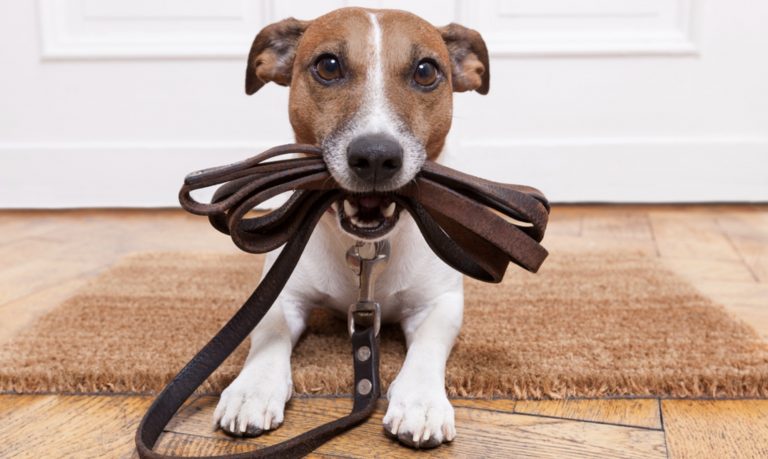

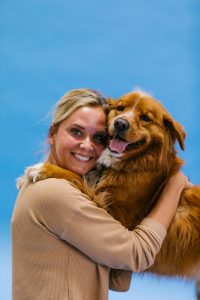
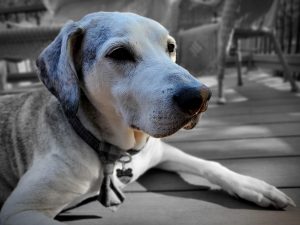
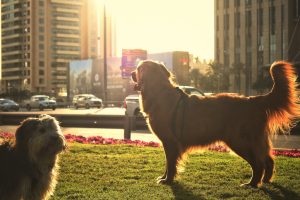
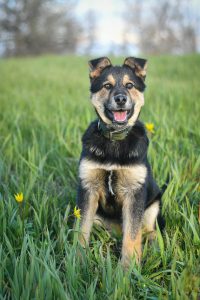
2 Responses
In your article, Dog Reactive Training – Prevent Accidents Before they Happen, what do you mean by point #2 in the section Simple Tricks when you say “Instruct your dog to look at its paws and shush”? Could you explain how and in what situation to do this? Do you do this while on a walk?
You take a treat, lure your dog with the treat to look down to its paws, and let it sniff. When your dog sniffs the treat, it cannot bark or do anything else with its mouth, meaning you put him in Shush (quiet) state. Reward the quiet state. Work on it all the time, and over time, your dog will know to look down (meaning not looking at a stimulus), and be quiet. Does this explain it? feel free to ask anything if it is not clear enough. And yes, you can do it on walks. If your dog is easily distracted, you can begin practicing at home, and then when your dog masters the movement / cue, try it in low-distraction area